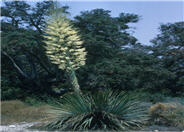
Common name:Adam's Needle
Botanical name:Yucca filamentosa
WIth stemless leaves that grow 2.5" long and 1.5" wide, the Yucca filamentosa produces tall, white flower spikes during the summer months.
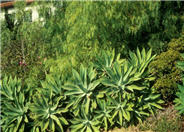
Common name:Fox Tail Agave, Velvet Agave
Botanical name:Agave attenuata
This Agave has a dramatic tropical form. Even light frost can damage its succulent leaves. It is great for containers. In the low desert, partial sun will be best. If it becomes top heavy, simply cut and stick in the ground to root. It is not a fast grower and has light green foliage. It will also die after flowering but pups around the mother will survive. Distinctive with its large rosette of leaves perched on a long curving trunk, it is a native from Mexico.
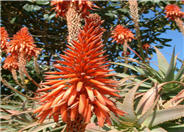
Common name:Tree Aloe
Botanical name:Aloe arborescens
This shrub is large, full of branches and produces deep orange blooms. The flowers produce a nectar that is attractive to many different birds; this plant is grown all over the world.
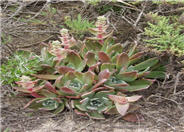
Common name:Dudleya
Botanical name:Dudleya cultivars
Dudleya cultivars are very numerous and they are typically low rosette shaped succulents. They are wonderful accent plants and work well in pots.
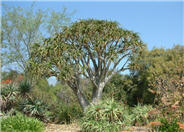
Common name:Baines Tree Aloe
Botanical name:Aloe barberae
This slow-growing tree has a heavy trunk with forking branches. It produces 2'-3' leaves in rosettes and rose/pink flowers.
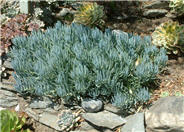
Common name:Kleinia
Botanical name:Senecio mandraliscae
This succulent perennial will grow to about 1.5' tall and 2' wide. It has curved, bluish gray leaves that are about 3.5" long and very slender.
Solving Runoff Problems
Importance of Watershed
A watershed is a land area that drains rain and other water into a creek, river, lake, wetland, or groundwater aquifer. Water from your neighborhood also enters the watershed through the storm drain system and flows directly to local creeks without any treatment. It often is contaminated by pollutants that can be toxic to fish, wildlife, and people.Click in the green box for more information
| Designer: anon | Succulent Garden and Dry Creek Bed |
Photographer: GardenSoft |
Soils and Compost:
Incorporate compost 6" into your soil to retain water, reduce compaction, feed earthworms, and provide valuable nutrients to your plants.
Water Saving Tip:
Mulching and adding compost to soil can minimize evaporation and help soil absorb and store water.
Integrated Pest Management:
Attract, or buy beneficial insects such as ladybugs and lacewings to control pest outbreaks in your garden.
